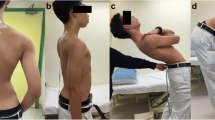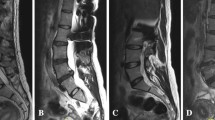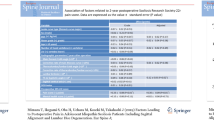Abstract
Purpose
To evaluate the impact of the flexibility of thoracolumbar or lumbar (TL/L) curves on low back pain (LBP) and disc degeneration in adult patients nonoperatively treated for adolescent idiopathic scoliosis (AIS).
Methods
Forty-seven adult patients (46 women; mean age, 40.5 years) nonoperatively treated for AIS with TL/L curves were included. The patients completed radiological examinations, magnetic resonance imaging, and a questionnaire survey for LBP evaluation. The flexibility of the spinal deformity was evaluated using supine side-bending radiographs. Radiographic measurements were correlated with scores for LBP and disc degeneration.
Results
The average magnitude and flexibility of the TL/L curve were 49.0° and 56%, respectively. The magnitudes of the TL/L curve and disc wedging were significantly correlated with LBP (|r|= 0.3–0.4). The flexibility of the TL/L curve and disc wedging, and the lumbar lateral range of motion (ROM) were significantly correlated with LBP and disc degeneration (|r|= 0.3–0.5). After controlling for the magnitudes of the TL/L curve and disc wedging, the flexibility of L4/5 disc wedging and the lumbar lateral ROM remained significantly correlated with the Scoliosis Research Society-22 pain score (partial correlation coefficient [r′] = 0.5 and 0.3), Oswestry Disability Index (− 0.3 and − 0.3), and disc degeneration (− 0.4 and 0.3).
Conclusion
In AIS patients with TL/L curves, the flexibility of L4/5 disc wedging and the lumbar lateral ROM were significantly correlated with LBP and disc degeneration, independent of the magnitudes of the coronal deformities. Our findings indicate that maintaining or improving lumbar flexibility may be beneficial for preventing or treating LBP.


Similar content being viewed by others
Data availability
The datasets generated during and/or analyzed during the current study are not publicly available but are available from the corresponding author on reasonable request.
References
Agabegi SS, Kazemi N, Sturm PF et al (2015) Natural history of adolescent idiopathic scoliosis in skeletally mature patients: a critical review. J Am Acad Orthop Surg 23:714–723. https://doi.org/10.5435/JAAOS-D-14-00037
Weinstein SL (2019) The natural history of adolescent idiopathic scoliosis. J Pediatr Orthop 39:S44–S46. https://doi.org/10.1097/BPO.0000000000001350
Chan P, Skaggs DL, Sanders AE et al (2017) Pain is the greatest preoperative concern for patients and parents before posterior spinal fusion for adolescent idiopathic scoliosis. Spine (Phila Pa 1976) 42:E1245–E1250. https://doi.org/10.1097/BRS.0000000000002147
Watanabe K, Ohashi M, Hirano T et al (2020) Health-related quality of life in nonoperated patients with adolescent idiopathic scoliosis in the middle years: a mean 25-year follow-up study. Spine (Phila Pa 1976) 45:E83–E89. https://doi.org/10.1097/BRS.0000000000003216
Diebo BG, Shah NV, Boachie-Adjei O et al (2019) Adult spinal deformity. Lancet 394:160–172. https://doi.org/10.1016/S0140-6736(19)31125-0
Weinstein SL, Dolan LA, Wright JG et al (2013) Effects of bracing in adolescents with idiopathic scoliosis. N Engl J Med 369:1512–1521. https://doi.org/10.1056/NEJMoa1307337
Ohashi M, Watanabe K, Hirano T et al (2020) Flexibility of the thoracic curve and three-dimensional thoracic kyphosis can predict pulmonary function in nonoperatively treated adult patients with adolescent idiopathic scoliosis. J Orthop Sci 25:551–556. https://doi.org/10.1016/j.jos.2019.06.015
Ohashi M, Watanabe K, Hirano T et al (2018) Predicting factors at skeletal maturity for curve progression and low back pain in adult patients treated nonoperatively for adolescent idiopathic scoliosis with thoracolumbar/lumbar curves: a mean 25-year follow-up. Spine (Phila Pa 1976) 43:E1403–E1411. https://doi.org/10.1097/BRS.0000000000002716
Ohashi M, Watanabe K, Hirano T et al (2019) The natural course of compensatory lumbar curves in nonoperated patients with thoracic adolescent idiopathic scoliosis. Spine (Phila Pa 1976) 44:E89–E98. https://doi.org/10.1097/BRS.0000000000002779
Pfirrmann CW, Metzdorf A, Zanetti M et al (2001) Magnetic resonance classification of lumbar intervertebral disc degeneration. Spine (Phila Pa 1976) 26:1873–1878. https://doi.org/10.1097/00007632-200109010-00011
Glassman SD, Berven S, Bridwell K et al (2005) Correlation of radiographic parameters and clinical symptoms in adult scoliosis. Spine (Phila Pa 1976) 30:682–688. https://doi.org/10.1097/01.brs.0000155425.04536.f7
Schwab FJ, Smith VA, Biserni M et al (2002) Adult scoliosis: a quantitative radiographic and clinical analysis. Spine (Phila Pa 1976) 27:387–392. https://doi.org/10.1097/00007632-200202150-00012
Glassman SD, Bridwell K, Dimar JR et al (2005) The impact of positive sagittal balance in adult spinal deformity. Spine (Phila Pa 1976) 30:2024–2029. https://doi.org/10.1097/01.brs.0000179086.30449.96
Jackson RP, Simmons EH, Stripinis D (1989) Coronal and sagittal plane spinal deformities correlating with back pain and pulmonary function in adult idiopathic scoliosis. Spine (Phila Pa 1976) 14:1391–1397. https://doi.org/10.1097/00007632-198912000-00018
Hasegawa K, Okamoto M, Hatsushikano S et al (2016) Normative values of spino-pelvic sagittal alignment, balance, age, and health-related quality of life in a cohort of healthy adult subjects. Eur Spine J 25:3675–3686. https://doi.org/10.1007/s00586-016-4702-2
Yukawa Y, Kato F, Suda K et al (2018) Normative data for parameters of sagittal spinal alignment in healthy subjects: an analysis of gender specific differences and changes with aging in 626 asymptomatic individuals. Eur Spine J 27:426–432. https://doi.org/10.1007/s00586-016-4807-7
Adams MA, Mannion AF, Dolan P (1999) Personal risk factors for first-time low back pain. Spine (Phila Pa 1976) 24:2497–2505. https://doi.org/10.1097/00007632-199912010-00012
Van Nieuwenhuyse A, Crombez G, Burdorf A et al (2009) Physical characteristics of the back are not predictive of low back pain in healthy workers: a prospective study. BMC Musculoskelet Disord 10:2. https://doi.org/10.1186/1471-2474-10-2
Ohashi M, Bastrom TP, Marks MC et al (2020) The benefits of sparing lumbar motion segments in spinal fusion for adolescent idiopathic scoliosis are evident at 10 years postoperatively. Spine (Phila Pa 1976) 45:755–763. https://doi.org/10.1097/BRS.0000000000003373
Deviren V, Berven S, Kleinstueck F et al (2002) Predictors of flexibility and pain patterns in thoracolumbar and lumbar idiopathic scoliosis. Spine (Phila Pa 1976) 27:2346–2349. https://doi.org/10.1097/00007632-200211010-00007
Funding
This work was supported by a grant from the Japan Orthopaedics and Traumatology Research Foundation Inc. (No. J16G0016).
Author information
Authors and Affiliations
Contributions
MO, KW, TH, KH, KK, HT, and YS: conception and design of the work; MO, KW, TH, KH, KK, HT, and YS: acquisition and analysis of data; HK: conceptual advice and supervision; MO, KW, TH, and KH: interpretation of data; MO, KW, TH, KH, KK, HT, YS, and HK: drafted the work; MO, KW, TH, KH, KK, HT, YS, and HK: substantively revised the work; MO, KW, TH, KH, KK, HT, YS, and HK: approved the submitted version.
Corresponding author
Ethics declarations
Conflict of interest
The submitted manuscript does not contain any information about medical device(s)/drug(s). No relevant financial activities exist outside the submitted work.
Ethical approval
The study was approved by the ethics committee of the Niigata University Graduate School of Medical and Dental Sciences.
Consent to participate and for publication
The written informed consent was obtained from all patients.
Additional information
Publisher's Note
Springer Nature remains neutral with regard to jurisdictional claims in published maps and institutional affiliations.
Rights and permissions
About this article
Cite this article
Ohashi, M., Watanabe, K., Hirano, T. et al. Impact of the flexibility of the spinal deformity on low back pain and disc degeneration in adult patients nonoperatively treated for adolescent idiopathic scoliosis with thoracolumbar or lumbar curves. Spine Deform 10, 133–140 (2022). https://doi.org/10.1007/s43390-021-00402-7
Received:
Accepted:
Published:
Issue Date:
DOI: https://doi.org/10.1007/s43390-021-00402-7




